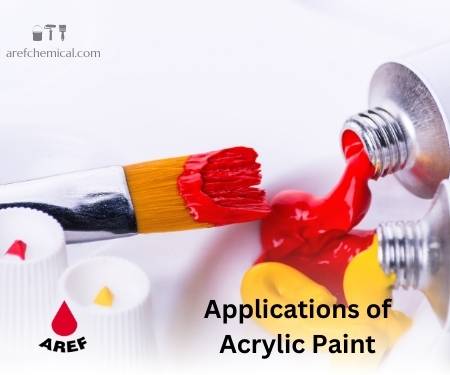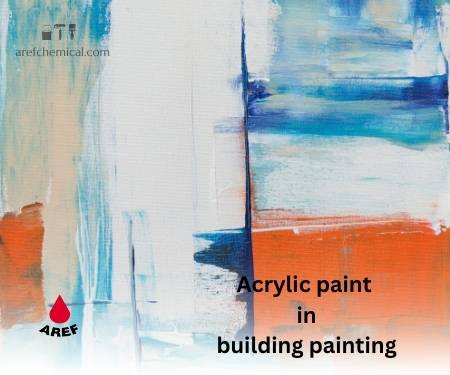What is acrylic paint?
Acrylic paint is a type of paint consisting of suspended pigments, which is made in the acrylic polymer emulsion bed. This type of paint is known for its quick drying time, versatility, and ability to create a wide variety of textures and effects. It is water-based, which means it can be easily washed with diluted water.
Acrylic paint is used in the construction industry and art. This paint is commonly used by both beginners and professional artists for various art projects such as painting on canvas, wood, paper, and other surfaces.
Characteristics of acrylic paint
This paint has several unique properties. It dries quickly, usually within 15-20 minutes, and creates a flexible and durable film. It is water-based, which means This paint can be diluted with water. Acrylic paint is very famous and popular among users due to its vivid and shiny spectrum from the classic RAL color chart.
Also, its ability to stabilize color over a long period of time without fading is notable. It can be used on different surfaces including walls, canvas, wood, paper, and even fabric. In addition, acrylic paint is versatile and can be used in various painting techniques such as layering, glazing, and impasto.
Advantages and Disadvantages of acrylic paint
Advantages:
Acrylic paint has several advantages. It dries quickly and is completely harmless to human health. It is also known for its vivid colors and durability.
- Low odor: This paint does not have an unpleasant odor due to the lack of the need to use thinners and strong thinners.
- Flexibility: Those are very flexible and can be used on all surfaces including paper, fabric, leather, wood, etc. This paint cracks later than oil paint.
- Stability: It is water-based, so its resistance increases after drying.
- Washable: These paints can be easily cleaned with soap and water.
- Drying speed: This paint dries very quickly and can be repaired easily after drying.
- High concentration: the coverage of acrylic paints is very high, and for this reason, their use is cost-effective.
- Wide color range: they have wide and unique color ranges and can be easily changed by using varnishes.
- Health: Acrylic does not harm the environment and human health
- Durability: It is very resistant to bright light and ultraviolet rays and does not change color.
Disadvantages:
- Sensitivity to low temperature: This paint dries slowly at low temperatures and cold.
- Impact resistance: it can be broken against strong impacts.
Applications of acrylic paint
Acrylic paint can be used on various surfaces including walls, canvas, wood, paper, and even metal. It can be used in art such as painting and even airbrush. This paint is versatile and can be diluted with water or acrylic polymer to create different effects and textures.
This paint is also used in mixed media projects, allowing artists to combine it with other materials such as collages or pastel elements.
Additionally, acrylic paint is less suitable for certain techniques such as glazing or layering, as it can become opaque when applied in thick layers. Overall, this type of paint is a popular choice due to its fast drying time, versatility, and vibrant colors. But it may not be the best option for every painting technique or style.
Is acrylic paint toxic?
This paint is generally considered to be on the non-toxic chemical spectrum, but it is always recommended to check the brand and product specifications for any safety information or warnings. Some of them may contain chemicals that can be harmful if swallowed or inhaled in large amounts. Therefore, it is recommended to use them in well-ventilated places and avoid direct contact with skin or eyes.
Acrylic paint resistance
It is known for its durability and resistance to atmospheric factors, and it is considered a good choice for exterior and interior surfaces. This product can withstand sunlight, humidity, and temperature changes without fading or cracking. However, it is always recommended to use a protective resin or sealant for added protection, especially for outdoor use.
Acrylic paint for painting metal surfaces
It can be used on metal surfaces, but may not adhere as well as other paints specifically designed for metal. It is recommended to use a primer for metal surfaces before using this type of paint to ensure better adhesion and durability. In addition, applying a clear coat or resin after the paint has dried can help protect it and extend its life on metal surfaces.
Acrylic paint primer
Acrylic paint primer is a type of primer specifically designed for use with acrylic paint. This primer is a preparatory coating that is applied to the surface before applying acrylic paint. The purpose of using a primer is to create a smooth and uniform surface for sticking the paint, as well as to increase its durability and longevity.
Acrylic paint primers are usually water-based and can be applied by brush, roller, or spray. These liners are available in different formulations and in three states: transparent, white, or colored, and can be used on different surfaces including metal, wood, and plastic.
The difference between acrylic paint and oil paint
Acrylic paint and oil paint are two different types of paint with distinct characteristics that are sometimes mistakenly considered the same type.
Acrylic is water-based and dries quickly. It is made of suspended pigments in acrylic polymer emulsion. It is known for its versatility, as it can be used on various surfaces such as canvas, wood, paper, and even metal. Acrylic paint is also known for its vivid colors and ability to hold its color over time. It is easily cleaned with water and does not require special solvents.
But oil paint is made from pigments suspended in oil (usually linseed oil). Compared to acrylic, it has a shorter drying time, which allows for more color blending and layering. Oil paint is known for its rich and deep colors and its ability to create smooth and glossy surfaces. Oil paint is often preferred due to its long-lasting durability.
In summary, the main difference between acrylic paint and oil paint is drying time, transfer characteristics, and the type of surface it is best suited for.
The difference between acrylic paint and plastic paint
Acrylic paint and plastic paint are two different types of paint with distinct characteristics.
Plastic paint is specifically formulated for use on plastic surfaces. It adheres well to plastic and provides a durable coating. Plastic paint is usually oil-based or solvent-based, meaning it requires a special type of solvent to thin and clean. It may also require a primer or adhesion promoter to ensure proper adhesion to the plastic surface.
In summary, while both acrylic and plastic paint can be used for painting, they have different compositions and properties. Acrylic paint is versatile and can be used on a variety of surfaces, while plastic paint is specifically formulated for use on plastic surfaces.
All kinds of construction acrylic paints
There are different types of acrylic paints that are commonly used in construction projects. Some of the most common types are:
- Exterior acrylic paint: This type of paint is specifically formulated to withstand exterior conditions such as UV rays, moisture, and temperature changes, and is often used to paint the exterior walls of buildings.
- Interior acrylic paint: This type of paint is designed for use on walls and interior surfaces. It usually has little odor and dries quickly and is suitable for indoor projects.
- Glossy acrylic paint: This type of paint has a glossy and reflective finish. It is usually used to highlight architectural details or create a stylish and modern look.
- Satin acrylic paint: This type of paint has a soft and velvety coating that is matte and glossy and is usually used for painting walls and ceilings in residential and commercial buildings.
- Matte acrylic paint: Matte paint has a smooth and non-reflective coating. It is often used to create a smooth and uniform appearance on walls and other surfaces.
These are just a few examples and there may be other types of This paints specifically for specific construction applications.
Acrylic paint wash
Surfaces painted with This paint can be washed. However, it is important to use a gentle, non-abrasive cleaning method and avoid harsh chemicals, as they may damage the paint.
The washing method depends on the type of foundation and primer and the brand of its main color. In the case of underlying oil paint, after the paint dries, it can be easily washed. But if you use plastic paint as a lining, you should know that the washability of this paint will be greatly reduced.
Acrylic paint solvents
Its solvent is a substance that is used to dilute or dissolve paint. The solvent is used to clean brushes and other painting tools, as well as to remove dried paint. This paint solvents can be different, some of the common solvents for this paint are water, industrial alcohol, and mineral spirits.
Choosing the right solvent is very important in the application of acrylic paint.
The method of painting surfaces with acrylic paint
To use This type of paint to paint surfaces, you need a few tools such as brushes, palettes, and a suitable surface for painting. The steps for using this paint are as follows:
- Prepare your surface: Make sure the surface is clean and dry. If necessary, you can cover the surface with a special primer before use.
- Prepare the paint: remove the desired colors of acrylic paint from the tube on your palette. You can combine different colors to create new shades.
- Dip your brush: Dip your brush in paint and make sure it’s evenly coated. You can also use different brush sizes and shapes for different effects.
- Apply paint: Start applying paint to your surface using a brush. Color can be layered to create depth and texture. Note that acrylic paint dries quickly, so keep this in mind.
- Clean your brushes: After you finish painting, clean your brushes with mild soap and water. Acrylic paints are water-based, so they can be easily washed off with water.
- Give the paint time to dry: Acrylic paint usually dries in 15-20 minutes, but it can take longer depending on the thickness of the paint, humidity, and ambient temperature. Make sure the paint is completely dry before applying additional layers.
Have fun experimenting with different techniques and styles!








12 Responses
This is fantastic and the most complete blog I have ever read on this topic
Thanks
Acrylic paint was very useful.
so good thanks
https://behdama.com/%d9%87%d9%88%d8%a7%d8%b3%d8%a7%d8%b2-%da%86%db%8c%d8%b3%d8%aa/
great
https://tavatranslation.com/%da%a9%d8%a7%d8%b1-%d8%af%d8%b1-%d9%81%d8%b1%d8%a7%d9%86%d8%b3%d9%87/
good luck
https://daroosf.com/%D9%85%DA%A9%D9%85%D9%84-%D8%A7%D9%86%D8%B1%DA%98%DB%8C-%D8%B2%D8%A7/
oh my God
https://qomtamirat.com/
yes exactly
https://arefchemical.ir/%d8%a7%d9%86%d9%88%d8%a7%d8%b9-%d8%b1%d9%86%da%af-%d8%b3%d8%a7%d8%ae%d8%aa%d9%85%d8%a7%d9%86%db%8c/
i agree with you
https://behdama.com/%d8%b3%d8%ae%d8%aa%db%8c-%da%af%db%8c%d8%b1-%d8%a2%d8%a8/
oh thanks
https://qomtamirat.com/
good points
https://daroosf.com/%D9%88%DB%8C%D8%AA%D8%A7%D9%85%DB%8C%D9%86-%D8%AF%DB%8C-%D8%AF%D8%B1-%DA%A9%D9%88%D8%AF%DA%A9%D8%A7%D9%86/
oh yes
https://daroosf.com/%D9%88%DB%8C%D8%AA%D8%A7%D9%85%DB%8C%D9%86-%D8%AF%DB%8C-%D8%AF%D8%B1-%DA%A9%D9%88%D8%AF%DA%A9%D8%A7%D9%86/